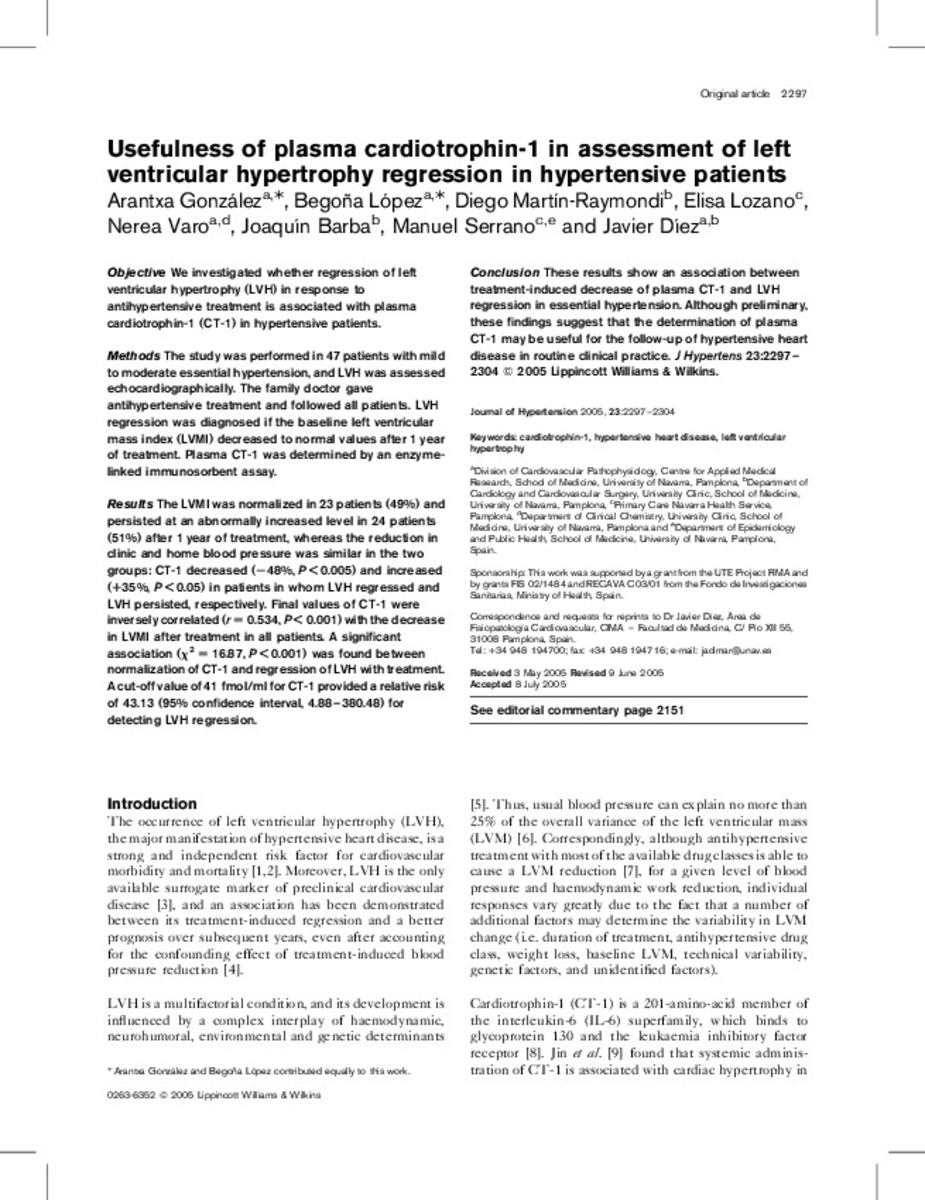Full metadata record
| DC Field | Value | Language |
|---|---|---|
| dc.creator | Gonzalez, A. (Arantxa) | - |
| dc.creator | Lopez-Salazar, M.B. (María Begoña) | - |
| dc.creator | Martin-Raymondi, D. (Diego) | - |
| dc.creator | Lozano, E. (Elisa) | - |
| dc.creator | Varo-Cenarruzabeitia, M.N. (Miren Nerea) | - |
| dc.creator | Barba, J. (Joaquín) | - |
| dc.creator | Serrano, M. (Manuel) | - |
| dc.creator | Diez-Martinez, J. (Javier) | - |
| dc.date.accessioned | 2011-11-28T09:54:06Z | - |
| dc.date.available | 2011-11-28T09:54:06Z | - |
| dc.date.issued | 2005 | - |
| dc.identifier.citation | Gonzalez A, Lopez B, Martin-Raymondi D, Lozano E, Varo N, Barba J, et al. Usefulness of plasma cardiotrophin-1 in assessment of left ventricular hypertrophy regression in hypertensive patients. J Hypertens 2005 Dec;23(12):2297-2304. | es_ES |
| dc.identifier.issn | 0263-6352 | - |
| dc.identifier.uri | https://hdl.handle.net/10171/19956 | - |
| dc.description.abstract | OBJECTIVE: We investigated whether regression of left ventricular hypertrophy (LVH) in response to antihypertensive treatment is associated with plasma cardiotrophin-1 (CT-1) in hypertensive patients. METHODS: The study was performed in 47 patients with mild to moderate essential hypertension, and LVH was assessed echocardiographically. The family doctor gave antihypertensive treatment and followed all patients. LVH regression was diagnosed if the baseline left ventricular mass index (LVMI) decreased to normal values after 1 year of treatment. Plasma CT-1 was determined by an enzyme-linked immunosorbent assay. RESULTS: The LVMI was normalized in 23 patients (49%) and persisted at an abnormally increased level in 24 patients (51%) after 1 year of treatment, whereas the reduction in clinic and home blood pressure was similar in the two groups: CT-1 decreased (-48%, P < 0.005) and increased (+35%, P < 0.05) in patients in whom LVH regressed and LVH persisted, respectively. Final values of CT-1 were inversely correlated (r = 0.534, P < 0.001) with the decrease in LVMI after treatment in all patients. A significant association (chi2 = 16.87, P < 0.001) was found between normalization of CT-1 and regression of LVH with treatment. A cut-off value of 41 fmol/ml for CT-1 provided a relative risk of 43.13 (95% confidence interval, 4.88-380.48) for detecting LVH regression. CONCLUSION: These results show an association between treatment-induced decrease of plasma CT-1 and LVH regression in essential hypertension. Although preliminary, these findings suggest that the determination of plasma CT-1 may be useful for the follow-up of hypertensive heart disease in routine clinical practice. | es_ES |
| dc.language.iso | eng | es_ES |
| dc.publisher | Lippincott, Williams & Wilkins | es_ES |
| dc.rights | info:eu-repo/semantics/openAccess | es_ES |
| dc.subject | Cardiotrophin-1 | es_ES |
| dc.subject | Hypertensive heart disease | es_ES |
| dc.subject | Left ventricular | es_ES |
| dc.title | Usefulness of plasma cardiotrophin-1 in assessment of left ventricular hypertrophy regression in hypertensive patients | es_ES |
| dc.type | info:eu-repo/semantics/article | es_ES |
| dc.relation.publisherversion | http://journals.lww.com/jhypertension/Abstract/2005/12000/Usefulness_of_plasma_cardiotrophin_1_in_assessment.23.aspx | es_ES |
Files in This Item:
Statistics and impact
Items in Dadun are protected by copyright, with all rights reserved, unless otherwise indicated.






